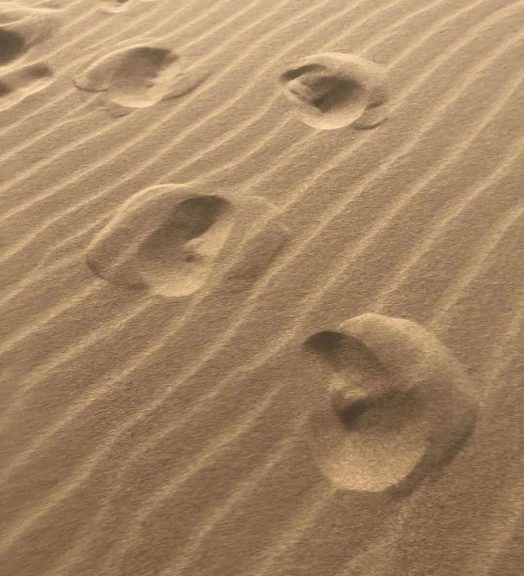
The Silk Road Excursion (Part 3): Buried in the Sand Dunes of Dunhuang
Hello, hello, again! I’ve been itching to post about our time in the desert town of Dunhuang for awhile because of camels and a sandstorm.
You might be saying, “Wait. Sandstorms?”
Just keep reading!
Some good news, our third overnight train to Dunhuang was a huge improvement from our train to Lanzhou. “I’m so glad this train ride isn’t as bad as last time,” was a common phrase that night. I noticed that the landscape outside quickly changed from common greenery like trees and grass to sand for as far as the eye can see.
Amongst the Dunes of Dunhuang
Dunhuang is a desert city that once was the last stop on the Silk Road before the route split off to the north and the south around the Taklamakan Desert. It served as an oasis for travelers before they journeyed into the harsh environment of the desert. The air in Dunhuang, and in the next two cities that we would visit in the west, was way drier, and one could notice the many signs that said “please save water!” in all of these towns. It was also hard to not notice the giant sand dunes in the distance, like mountains, and since it was particularly windy that first day in Dunhuang, you could see the clouds of sand being blown off the top of them. Seeing sand dunes in the horizon half of the time I looked around was bewildering. I’m used to seeing the concrete jungle of Chicago, and I’ve only seen sand dunes a handful of times on a beach. It was something else to see sand dunes constantly looming over the horizon.
Upon our arrival to Dunhuang, we hopped onto a bus and had breakfast at a hotel. The breakfast lounge had an outside patio where you could enjoy your breakfast while gazing out into the dunes in the horizon.
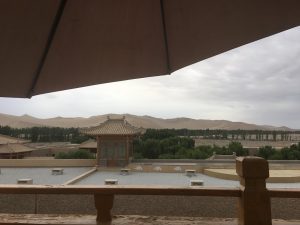
After breakfast, we took a bus to visit the breath-taking and ancient Mogao Caves.
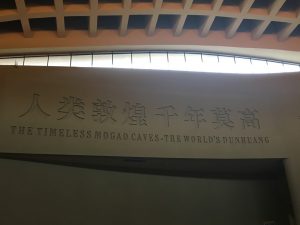
The Mogao Caves, also known as the Caves of the Thousand Buddhas, are the world’s largest collection of grotto Buddhist caves, filled with many relics and statues. Dunhuang had been a great centre of Buddhism, and after the founding of the Mogao Caves, the town was a major place of pilgrimage. The caves have Buddhist murals that are beautifully intricate and detailed, even though the paint has faded over the thousands of years. The oldest cave is from the 4th century! How could these caves stay so well preserved, you ask? It’s mostly because the location of these caves was so isolated that they stayed untouched after the caves were abandoned. They only resurfaced thanks to an explorer, Sir Aurel Stein, who stumbled upon the caves and discovered the “library cave,” which had an insanely rich collection of 60,000 paper manuscripts, documents, and more, the oldest of which dating from the 5th century. As a result of the age of the caves as well as the significance of these caves, we were not allowed to take pictures inside of the caves in order to prolong the further preservation of these murals.
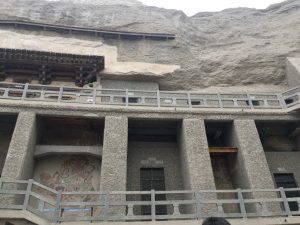
We only saw a handful of caves, and every single one of them had paintings that I could only imagine how they looked like when they were fresh. We even saw a gigantic Buddha statue that was carved into cliff, a Buddha so big that you had to strain your neck to look up in order to see the entire statue.
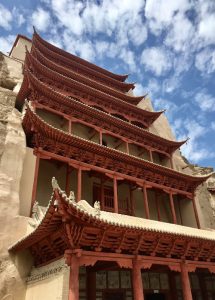
Once we our tour of some of the caves ended, we checked into our hotel and were given a free afternoon to eat lunch and pack our overnight bag. The plan was that we would go to a camping site out to the edge of the desert on a bus, and then we would spend the night there in tents. The hotel that we checked into would just serve as a place to store our bags and to wash up after our time in the desert. Many of us excitedly talked amongst ourselves about our upcoming activities during our free time. Camping in the desert would be a once-in-a-lifetime experience for all of us!
Getting to the campsite, though, was an experience in on itself. The original intention was that our bus driver would drop us off at the gate entrance to the campsite and then we would walk in. The gate entrance was separated from the main road by a tiny, tiny, metal bridge. When I say tiny, I mean we all thought that there was no way a bus could fit on it, let alone drive across it. But our bus driver decided that he would drive our bus across this tiny bridge and then past the gate entrance.
He drove us across a TINY bridge that was just barely the width of the bus just so we wouldn’t have to walk as far!
It’s obvious when I say that we were mad stressed when he slowly inched the bus across the bridge, and we shouted whenever we hit bumps. But, somehow, we got across that bridge and were driven further in.
Getting off of the bus, we were greeted by the campsite’s owners. The campsite had a small metal building that had a tall roof coming off and over the side of it to provide shelter. There were benches and tables arranged around the side of the building, and we set our stuff down here. The wind, which had been blowing pretty hard all day, had picked up even more, and sand was whipping around everywhere.
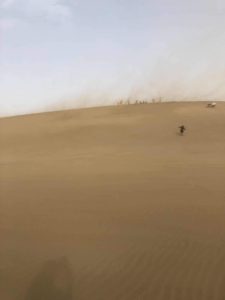
That didn’t stop any of us from kicking off our shoes and running out into the sand, dragging plastic sleds that the owners provided to us.
We shrieked and laughed as the sand unforgivingly blew against us, the grains uncomfortably hitting any of our exposed skin. If you opened your mouth, you were guaranteed to get mouthful of sand, and those of us who didn’t have sunglasses or any protective wear for your head had a rougher time than others. Trying to drag our feet through the slippery sinking sand was another story. But, determined to have a good time regardless of the weather, many of my peers and I hiked up the giant sand dune nearby
.
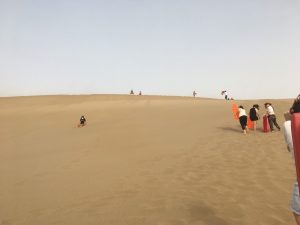
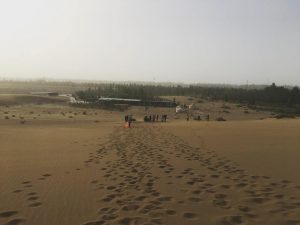
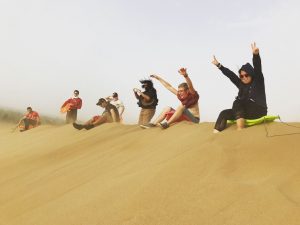
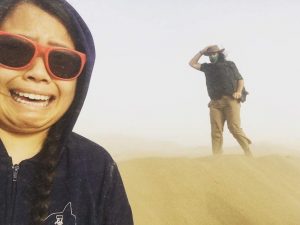
At the top of the dune, those of us brave enough to endure the sandstorm enjoyed the breathtaking view as we took careful hard breaths from the climb up. The sun was bright, and the horizon was just blurred out from all of the sand.
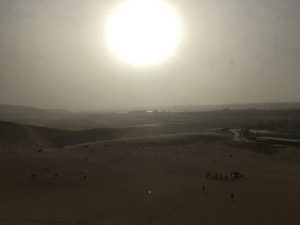
Sliding down the dune on those plastic sleds was another story. For those who haven’t been sledding before, you basically sit on a piece of hard plastic, scoot forward a little bit, and hope to gosh that you don’t wipe out as you speed down the hill. I managed to somehow slide down the dune without wiping out, but some of my other peers weren’t so lucky. Good thing that sand is relatively soft!
Once we had our fun in the sand, we trudged back underneath the safety of the roofed benched area. That is where we got some unfortunate news: because of the winds, camping out in the desert would be unsafe, lest one our tents with students in it gets carried off somewhere. Our plan was thus changed: we would get up at 5am the next morning in an attempt to ride the camels in the desert, weather permitting. We were disappointed, but we shrugged off the bad news quite easily. Me personally, I was glad to have experienced the desert sands (even if it was in the context of a literal sandstorm) and share some laughs with my fellow TBC peers. I was just really happy to be a part of a group that would fearlessly try to conquer a sandstorm, regardless of how much sand we got in our clothes, and would carry a positive attitude regardless of the outcome.
So, with our pockets full with sand, we hopped back onto the bus. At our hotel, we dumped sand out from our clothes, and spent the night at our hotel instead.
5am the next day, we all sleepily dragged ourselves out of bed and downstairs in our hotel lobby, bundled up for the cold weather out in the desert. We hoped that the weather that wasn’t as bad as the day before, just so we could at least ride the camels. Most of us, between camping and riding the camels, looked forward to the camel riding to see the sunrise the most. To our delight, the wind was basically gone, and the weather was determined safe for us and the camels to be outside. The moon was still out that early in the morning, and it was full and shone very brightly.
When we got to the location that offered camel rides into the desert, we were given tickets with a number on it. The number we were given matched with a number on a camel, and that camel would be the one we would ride.
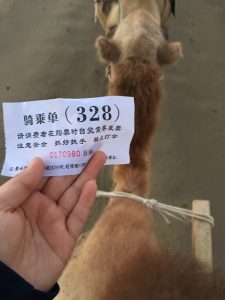

We were then divided into groups of five, and my group was lead to our camels. When we got to the place where all the camels patiently sat waiting, I was taken aback just at how many camels there were. I didn’t know what I was thinking, but I didn’t think that there were going to be that many camels all sitting there in the dark!
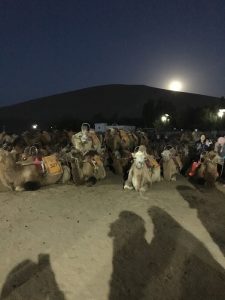
I hauled myself in-between the two humps of my camel where there was a saddle, gripping onto a metal bar in front of me. At the command of the camel leader, the camels got up onto their feet, and they followed him in a single file line on a specific route that would take us to yet another breath-taking scenery on this trip. Riding a camel is very similar to riding a horse, except there’s a more pronounce “sway” from side to side. There’s a kind of rhythm to it, and you just have to go with the flow or else you felt like you could fall off at any moment.
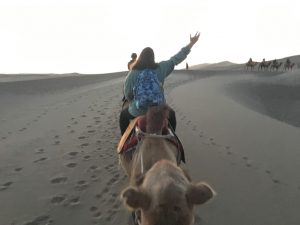
Perched on our camels and definitely awake at this point, we gazed around in awe as the morning sky turned from a dark navy blue to a light blue to a faint orange and right of the sunrise. The sand dunes were just as majestic as the mountains of Xia’he, if not more prettier because of the foreign landscape.
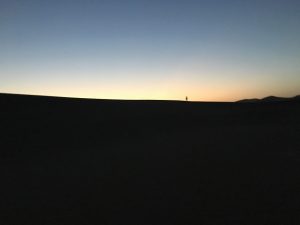
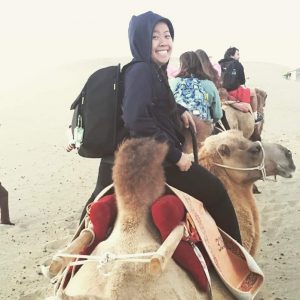
After awhile, the camel leader stopped and told the camels to lay back down (a process that’s pretty jarring, since it’s a sudden drop in height when the camel lays back down on its legs). We got off of our camels and trudged up a sand dune to watch the sunrise at the top and to take loads of pictures. That morning sunrise is probably one of the most beautiful I’ve ever seen. The sun was a distinct orange color, and the shadows of the sand dunes cast a mysterious feeling inside of me.
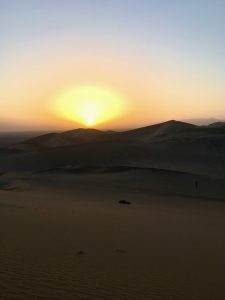
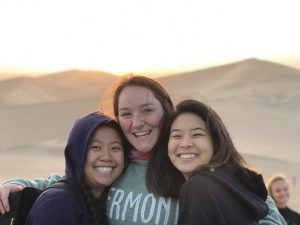
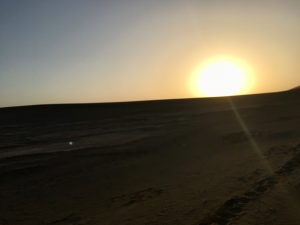
Our camel leaders ushered us back onto our camels after the sun climbed high in the sky, and we rode back down and then to Crescent Lake.
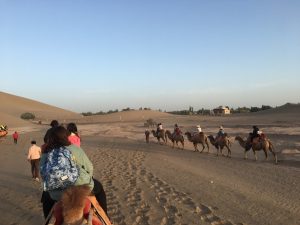
Crescent Lake is a precious source of water for thousands of years in Dunhuang. It is a small, and getting smaller, lake which lies just next to the towering sand dunes. Without this lake, it is debatable how human life could have survived in Dunhuang.
At Crescent Lake, we said goodbye to our camels and were given a small amount of free time to explore the area around the lake. My friends and I spent most of our time taking pictures near the lake and enjoying the scenery. You know, the usual stuff! 🙂
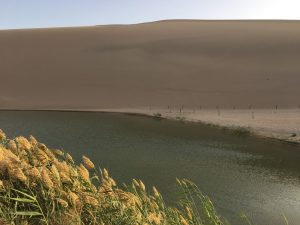
Once our time was up, we hopped onto a shuttle that took us back to the parking lot where our bus was. After all, we had to hurry and pack our bags to hop onto… you guessed it, another overnight train to get to our next destination, Turpan!
That’s it for our time in Dunhuang! Come back next time to hear about our explorations of some ancient city ruins in Turpan!
Until then~
-Justine